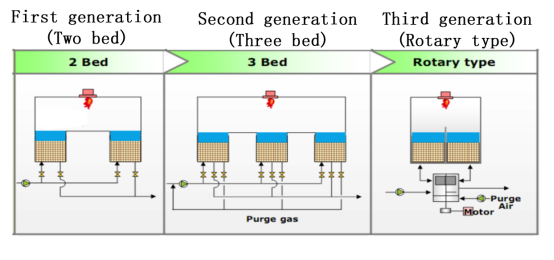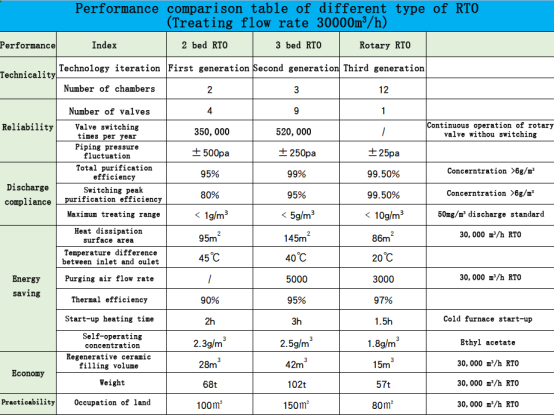This article is authorized to be reproduced from official account: Polaris Environmental Protection Network.(ID: bjx-huanbao).
Author: Biting Su.
RTO technology development history
RTO is the abbreviation of Regenerative Thermal Oxidizer.
RTO is develop on the basis of Thermal Oxidizer. The original RTO is to connect two TO in parallel, and added ceramic regenerative bed at the outlet, and repeatedly switch the inlet and outlet routes through poppet valves to achieve heat storage function, which is called RTO.
RTO of first generation technology has two regenerative chambers in structure, which realizes “heat storage function” and is called “two chamber RTO”or “two bed RTO”.
In order to solve the problem that Exhaust gas in regenerative chamber is directly discharged without high temperature purification when the heat release process is switched to heat storage process, an additional chamber is added on the basis of two chambers to realize the “Purging function” and become the three-chamber RTO, which is the second generation technology.
When RTO needs to treat large flow rate exhaust gas, the chamber volume of three-chamber RTO becomes large, there are defects such as uneven flow field distribution, large flow rate of purge air, large energy consumption, large amount of idle regenerative ceramics. Therefore, when the flow rate of exhaust gas is large, the second generation technology RTO will be made into a muti-chamber structure of 5-chamber, 7-chamber or 9-chamber, to ensure that each chamber is small.
When the second generation technology RTO is made into muti-chamber structure, because each chamber is equipped with three poppet valves of inlet, outlet and purging, the number of poppet valves is large and the action is frequent, and the reliability of muti-chamber RTO system is greatly reduce.
In order to solve the problems of many and unreliable of switching valves of multi-chamber RTO, RTO engineers invented “Rotary Gas Distribution Valve”, or”Rotary Valve” for short. One rotary valve can realize the switching functions of inlet, outlet and purging of dozens of poppet valves, and the structure is simple, stable and reliable.
Multi-chamber RTO with rotary valve is called “Rotary RTO”, which is RTO of the third generation technology.

Comparison of RTO structures of different types
The sealing structure of rotary distribution valve of rotary RTO is very critical, and the structure of “labyrinth lip rubber seal” must be adopted. At present, the global manufacturers mastering this technology include more than ten factories, such as Germany’s EISENMAN, Japan’s TED, Korea’s DEAYAND environment, Xi’an Yurcent, HANGZHOU Enwei , etc., with more than 2000 cases of stable operation around the world.
At the initial stage of RTO in China, some enterprises failed to master “labyrinth lip rubber seal” technology, and used “air curtain seal” instead, resulting in low purification efficiency, which briefly affected the promotion of rotary RTO in China. Later, Xi’an Yurcent and Hangzhou Enwei conquered “labyrinth lip rubber seal” technology, and the Chinese industry recognized the rotary RTO product only after more than 800 sets of long-term stable operation cases were achieved at home and abroad.
Compared with the third-chamber RTO, rotary RTO is characterized by small size, energy saving, low cost, stable operation, which represents technical development trend. The specific performance indicators are as bellow:

Performance comparison of different type of RTO(Flow rate: 30000m3/h)
Key points of RTO bidding technology selection
1、Pay attention to the misunderstanding caused by the name
Generally, the three-chamber or multi-chamber RTO with poppet gas distribution valves is arranged in straight line with rectangular shape, which is commonly know as “bed RTO”.
The multi-chamber RTO with rotary gas distribution valve is usually arranged around the center point, and its shape is circular, commonly known as “Rotary RTO”, and the rotary RTO also has rectangular shape.
The two types of RTO are fixed bed, the difference is that the distribution valve is different. When the rotary RTO is operating, the distribution valve rotates rather than the bed rotates.
·Key point 1: RTO bidding technology selection should distinguish RTO type by the type of distribution valve.
2、The core technology of RTO is thermal storage, so the selection of thermal storage performance is very important.
The thermal storage performance of RTO mainly depends on the temperature difference between the inlet and outlet. The smaller temperature difference between inlet and outlet, the better the thermal storage performance of RTO equipment. Generally, it is required to be less than 20℃.
The thermal storage performance of three-chamber or multi-chamber “bed RTO” with poppet gas distribution valve can also be compared by switching time of the poppet valves. The shorter the switching time, the better the thermal storage and energy saving performance.
·Key point 2: The upper limit of valve switching time and the upper limit of inlet and outlet temperature difference shall be set for the selection of RTO biding technology.
3、When treating large flow rate of exhaust gas, the more regenerative chambers of RTO, the more stable of structure and the better the energy saving performance.
Generally, more than 5 regenerative chambers are required to treat more than 50,000 m³/h of exhaust gas; More than 7 regenerative chambers are required to treat more than 10,000 m³/h of exhaust gas; More than 9 regenerative chambers are required to treat more than 15,000 m³/h of exhaust gas. The more regenerative chambers, the more stable.
·Key point 3: The lower limit of numbers of regenerative chambers shall be set for the RTO bidding technology, and the upper limit of numbers of regenerative chambers shall not be set.
4、“Bed RTO” and “Rotary RTO” can achieve single supper-large flow rate treating capacity through parallel arrangement.
At present, the maximum flow rate of “Bed RTO” operating case in China is 430,000 m³/h, and the maximum flow rate of “Rotary RTO” operating case in China is 270,000 m³/h.
·Key point 4: The selection of RTO bidding technology with supper-large flow rate need not limit the type of RTO.
5、The leakage rate of switching valve directly affect the purification efficiency of RTO.
·Key point 5: RTO bidding technology selection should clearly use “rubber seal poppet valve” or “rubber seal rotary valve”, and “air curtain seal poppet valve” or “air curtain seal rotary valve” is not allowed. The sealing type of valve should be limit, but the type of the distribution valve should not be limited.
6、Another major factor affect the purification efficiency of RTO is the residence time of exhaust gas in combustion chamber.
Because the VOCs composition of exhaust gas is large and varied under most working conditions, and the exhaust gas is generally mixed with high boiling copolymer, hydrogen, CO, CH4 and other combustibles that are not VOCs.
·Key point 6: RTO bidding technology selection should be set with a residence time of no less than 1.2 seconds, a gas flow velocity of no more than 2m/s, an oxygen content of no less than 5% in high temperature oxidation air distribution calculated for RTO based on the known VOCs composition.
Notes: The above description is a summary of personal research and learning achievement and experience, which is only for academic reference.
This article is reprinted from the website: huanbao.bjx.com.cn.